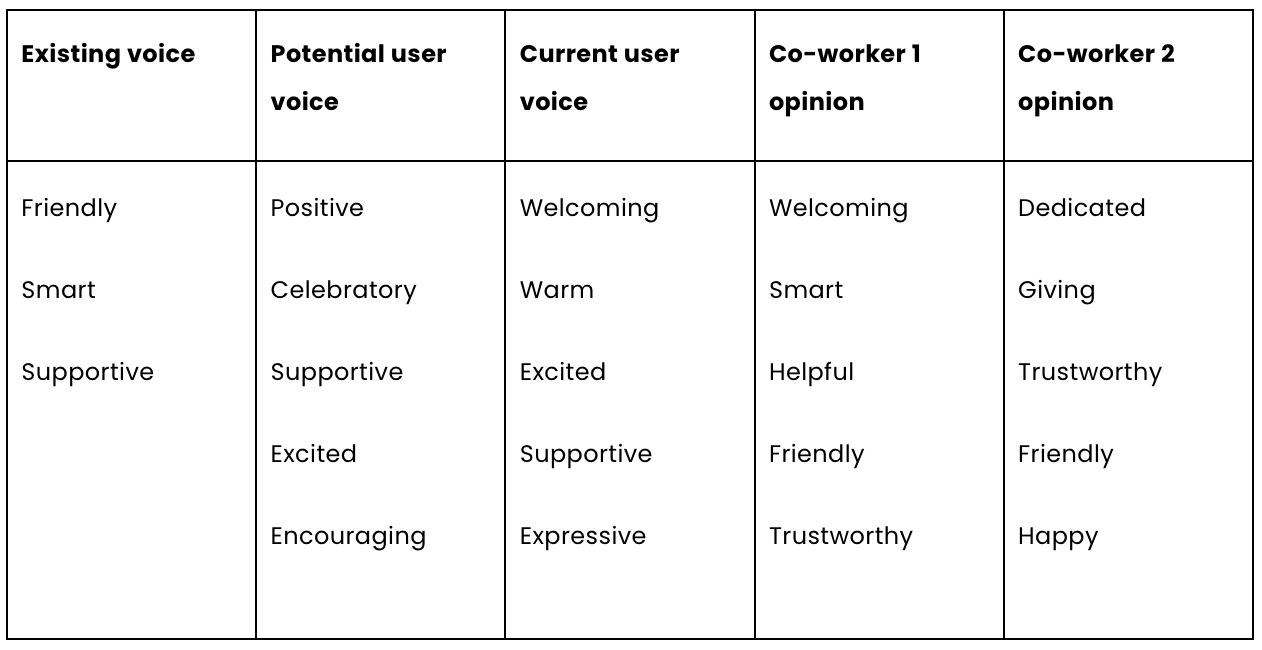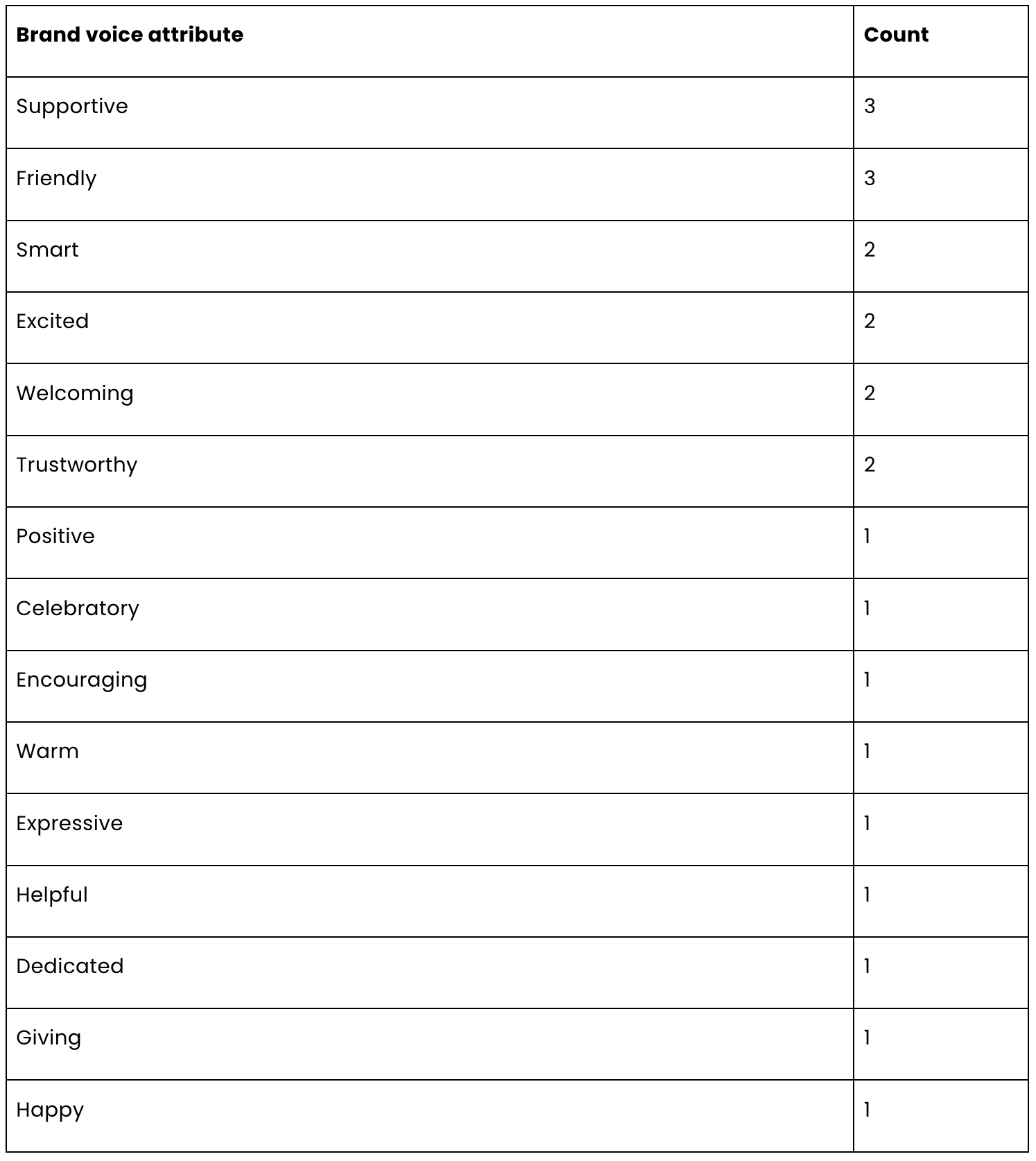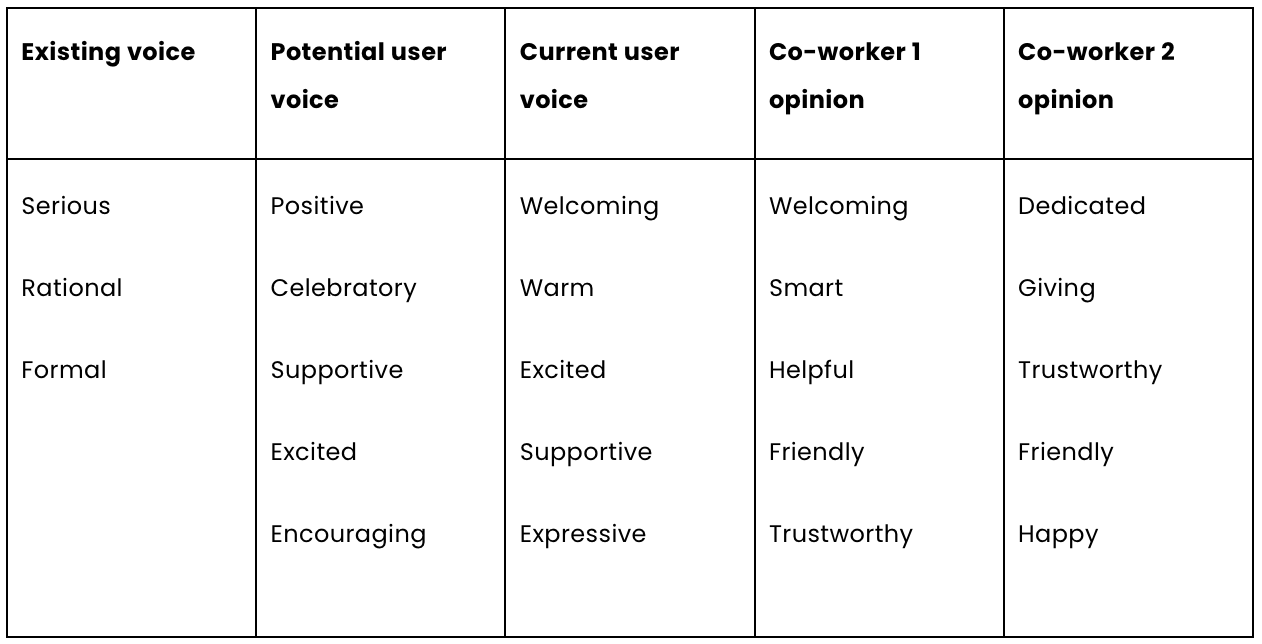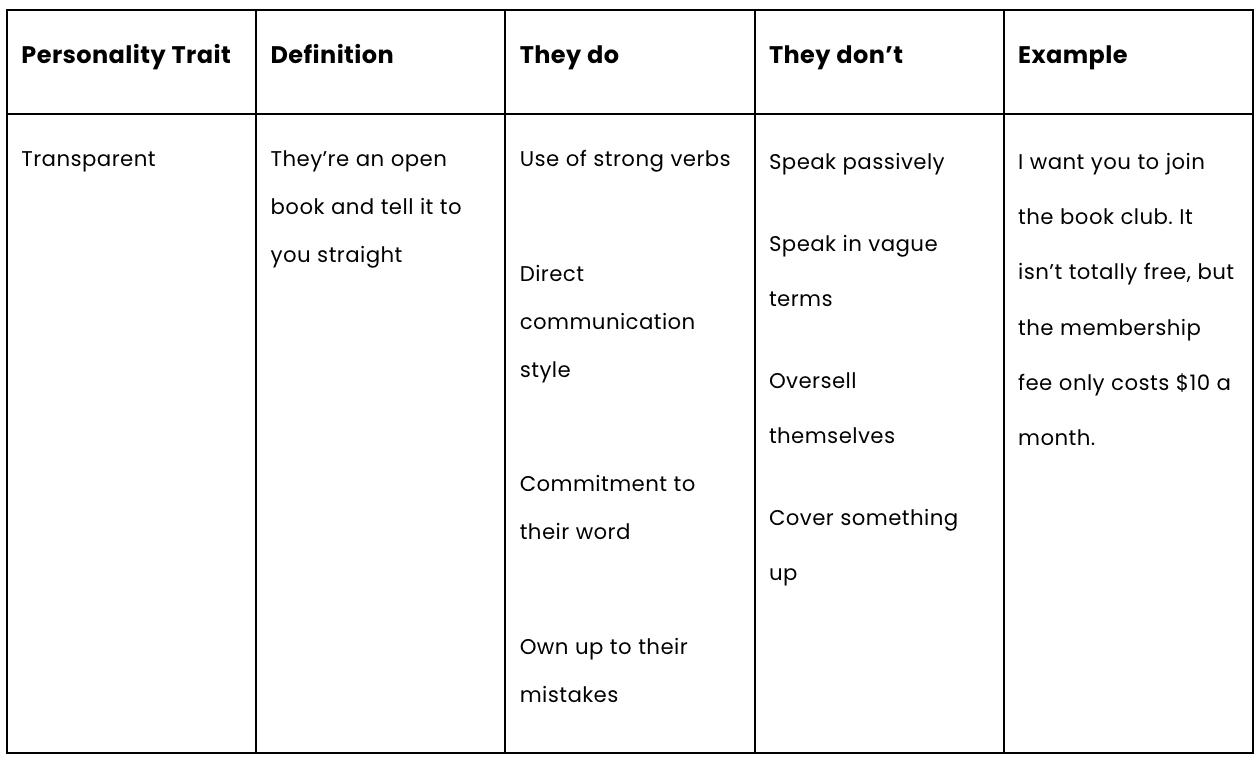Voice and tone guidelines keep your microcopy consistent from the get go. The best time to create them was yesterday. The second best time is today.
That’s because the earlier you set up the voice and tone guidelines and devise a system around using them, the earlier every piece of copy that gets shipped comes from a consistent place. This helps save future you time auditing, editing, and updating inconsistent language.
If you’re joining a company with a team of content designers, there’s a good chance there are already established product voice and tone guidelines. But if you’re joining a company that has bare-bones guidelines or needs them built from the ground up, I’m going to show you exactly how to build a product voice and tone.
Now, we can’t just pull a voice and tone out of thin air. Some people may think that’s how it’s done, but that’s a voice and tone rooted in subjectivity which fulfills what the creator wants, not what the user needs.
To create a voice and tone centered around the users, we need to gain an understanding of the product, what the company values, and who our users are.
There are 6 steps to build product voice and tone guidelines:
- Audit the existing microcopy
- Audit competitor microcopy
- Do some internet research
- Do some actual research
- Interview your co-workers
- Put the pieces together
1. Audit the existing microcopy
The first step is to take a big ‘ol look at how the product is currently communicating. The goal with this step is to define the voice for the company as it stands today. It’s important to define where the brand is today, so you can be strategic about where it’s going tomorrow.
Take screenshots of microcopy across the entire user experience, from sign up to onboarding to offboarding. Collect copy from emails that go out and push notifications that are triggered.
Collect all of these screenshots, and make a big collage in Figma or Google Slides (if you so prefer.)
I’ll be going through this with you using the plant care app, Greg, as an example. Here’s my big collage of Greg’s product voice:
Now, we’re going to sticky note the heck out of this collage. Start looking for:
- Consistencies
- Inconsistencies
- What’s working
- What isn’t
At first, make sticky notes anywhere something comes up, like this:
There’s no “wrong” thing to sticky note. When you’re sticky noting, you’re pointing out anything and everything that stands out. Once you have all your sticky notes done, you’re going to look for trends. The more sticky notes you have, the more trends you’ll potentially uncover.
Comb through your sticky notes and look for themes. Examples of themes I picked up from auditing Greg’s product voice are:
- Overall, there’s a casual vibe, with a liberal use of exclamation marks and colloquial words, like “recs” and “plant parents”
- But, there’s a formal air to Greg, which makes it appear smart, using words like “appear,” “adapt,” and “precision”
- Greg asks lots of questions and is very inquisitive. It asks the user what they want to do more than it tells the user what to do.
By doing this, you’ll get a general idea of what you’re dealing with and how it may potentially develop.
I like to end this step by giving the current product voice 3 – 5 voice attributes, or personality traits. By defining the attributes of the product voice as it stands today, again, we’ll have a foundation to build from.
I would describe Greg’s voice, or personality, today as:
- Friendly
- Smart
- Supportive
We’re going to define more voice attributes at almost every step, so buckle up for a lot of this kind of exercise. At the end, we’ll put together all the attributes list to gain an understanding of where Greg should go.
When picking voice attributes, think about how you would describe the product’s personality. If you’re struggling to think of personality traits, here’s a list of voice attributes to get the juices flowing:
- Relevant
- Curious
- Adventurous
- Fun
- Empathetic
- Courageous
- Competitive
- Friendly
- Calm
- Peaceful
- Creative
- Caring
- Reliable
- Simple
- Accountable
- Dynamic
- Altruistic
- Dedicated
- Professional
- Ambitious
- Joyful
- Determined
- Charming
- Passionate
- Transparent
- Blunt
- Cool
- Trendy
- Respectful
- Intelligent
- Provocative
- Elegant
- Sincere
- Mysterious
- Familiar
- Loyal
- Frugal
- Rational
- Loving
- Sensitive
- Generous
- Knowledgeable
- Nostalgic
- Traditional
2. Audit competitor microcopy
Now, you’re going to do the exact same thing for 1 – 3 competitors.
The goal here is to understand the competitive landscape, so you can find a way to stand out from the competition. You’re going to look for all the same things and try to identify as many trends as possible, just like you did for your company.
For example, one of Greg’s main competitors is an app called Planta. Here’s the collage I made of Planta’s product voice:
And just like I did with Greg, I’m going to look for themes using sticky notes, like this:
Then, just like I did with Greg, we’re going to want to define voice attributes, or personality traits, for Planta. I chose:
- Serious
- Formal
- Rational
You can also do a side-by-side analysis for similar events, features, or anything really:
Or this:
This helps you figure out how your company and the competition compare.
Again, I suggest deep-diving into 2 – 3 competitors, but you should also look broadly at other competitors. This will give you a sense of the overall market. And with a sense of the overall market, you can make a chart like this:
This is a competitive analysis chart, and it helps you see gaps in the market. The chart runs on two axes:
- Friendly to Formal
- Ordinary to Intelligent
When choosing axes, think about the spectrum of personalities in the space. For example, in fintech, you have Chase bank, formal and traditional, competing with Chime, youthful and only somewhat traditional. Also, think about the demographics and psychographics of your users, and what personality traits they’re looking for in a product.
There’s no perfect science to this, and you really just have to get a feel for the spectrum of personalities in the market and what users want. As another example, here’s a competitive market analysis chart for a fintech + travel app looking to appeal to Gen X:
Back to the Greg example, there are 3 gaps in the market:
- Any level of ordinary and formal
- Extremely friendly and extremely intelligent
- Extremely ordinary and extremely friendly
Don’t take these gaps as gospel. For example, no plant app wants to sound ordinary and formal — there’s a reason why there’s a gap in the market there. Same with extremely ordinary and extremely friendly — plant apps need credibility, and if they sound too ordinary, users won’t trust them.
What we can glean from this competitive market analysis chart is Greg is already in a gap in the market. We create a way for Greg to flex within that gap, but this is a good indication that Greg’s voice is already differentiated from a market perspective.
But the market isn’t everything — we also need to know what users think…
3. Do some internet research
Now that we’ve analyzed the market, we gotta learn where users’ heads are at. Well, start with potential users first. And that means internet stalking.
In this step, your goal is to learn:
- How your potential users talk and what language they use
- Identify a collective personality
- Understand their pain points and problems
- Understand their relationship with other users
Don’t just go on any ‘ol social media site and start analyzing posts — find where your users hang out. Not all users hang out on the same platform. Some are on Twitter, some are on Reddit, some LinkedIn, some TikTok, etc…
Once you find out where your potential users hang out, start collecting copy from posts. Put this post copy in a spreadsheet to build a database of sorts. Once you feel like you have a good sample size (50 lines is a fair call,) start highlighting anything that stands out when it comes to personality and word choice. There’s no wrong thing to highlight — the more you highlight, the more trends will emerge.
Then, look at what you highlighted, and find 3 – 5 voice attributes that sum up your potential user’s collective personality.
For example, Greg users hang out on two main subreddits:
- r/plantclinic
- r/houseplants
So, that’s where I went to hang out. I copied a ton of posts and put them into a spreadsheet “database.” Then I highlighted language that stood out to me in bold purple letters, like this:
After parsing through all the highlighted text, it’s clear the collective personality of potential Greg users can be summed up as:
- Positive
- Celebratory
- Supportive
- Excited
- Encouraging
5. Do some actual research (if you can)
Actual research is a great way to use what you know as a company and your users to shape the product voice. There are a few ways you can do some research:
- If your company has recordings of past research, watch videos, and listen to how users talk. What language do they use? What are their personalities like?
- If your company has some sort of community or forum, audit the posts and comments to understand how users talk, what language they use, and if there’s a common personality.
- Hang out with customer service, and sit in on customer calls for a few days. Listen for how users talk, their pain points, how they feel about your company, and what their personalities are like.
From actual research, you’re trying to glean:
- An understanding of the common personality of your users
- How your users talk and what language is familiar to them
- What they care about and what they value
- Their struggles and pain points
Based on what you’ll find, you’ll want to, again, attach your findings to 3 – 5 voice attributes.
For example, back to Greg, Greg has a raging community. To better understand how Greg’s users talk, I went through the community, and pulled samples of conversations into a spreadsheet. Then, I highlighted language that stood out in bold, purple letters, like this:
From this, I was able to identify that Greg has some emoji-lovin’, supportive, welcoming and passionate users who also really love Greg.
Based on this audit, I’d describe the common personality of Greg’s users as:
- Welcoming
- Warm
- Excited
- Supportive
- Expressive
I know we’re creating a list of voice attributes every step of the way, and this is key. At the end of this, you’ll look at all your collected voice attributes and make a strategic hypothesis as to what’ll be the best move forward. But more on that later…
6. Interview your co-workers
Find the people who are institutions at your company, and become their good friends. These people are a fountain of knowledge, and they’ll be your best insight into where the company has been, where it’s going, where it should go, what’s been tried, and what the company should try.
Present them with this question: “If our product was a person, what are 5 personality traits that would best describe us?”
You could even give them that list of voice attributes from a few steps ago.
Also ask what other products or competitors they believe your product should sound like and why. How do they think users should feel about your product?
The goal here is to try to get a general idea about what they think the current voice is or should be. I suggest talking to 2 – 5 people, and finding common ground between their answers.
For example, with Greg, I spoke with the two founders, Alex and Martin.
Alex said, if Greg was a person, they’d be:
- Welcoming
- Smart
- Helpful
- Friendly
- Trustworthy
Martin said, if Greg was a person, they’d be:
- Dedicated
- Giving
- Trustworthy
- Friendly
- Happy
Collectively, Alex and Martin listed the following companies as inspiration for the product voice:
- Slack
- HappyMoney
- Chime
- Postmates
- Spotify
- Figma
When describing how users should feel about Greg, words that came up were:
- Sidekick
- Pal
- Guide
- Genie
- Doctor
8. Put the pieces together
Now’s where our lists of voice attributes come into play. We’re going to use them to identify themes and trends, so we can make an informed decision as to what the new product voice attributes should be.
Here’s what that looks like for Greg:

There’s definitely some overlap here, and it seems like all these voice attributes from a similar place. To understand where we should go from here, compile each voice attribute into a list, and count the number of times it was mentioned.
Here’s what that looks like for Greg:

Based on this ranking, we landed on the following voice attributes for Greg’s product voice:
- Supportive
- Friendly
- Smart
- Excited
- Welcoming
- Trustworthy
You might be thinking “supportive,” “friendly,” and “smart” were already attributes of Greg’s original voice. You’re not really changing a whole lot…
That’s true! And it’s informed by our research. Remember our competitive market analysis?
Here, we learned that Greg already sits in a competitively advantageous position. If we can upgrade and edit Greg to even better sit within that competitive position, the product voice can thrive even more.
Unlike some companies, Greg wasn’t in the position where a complete change of direction was needed — just an update and further definition.
Be realistic about where your company falls. You made need a lot, or you may just need a little.
But what if the current voice doesn’t align with everything else?
More often than not, there will be clear trends to identify. But sometimes, what the users want and where the product is today is quite different.
In that case, you’ll want to make an informed decision about the future of the product. The goal of a product voice is to better resonate with your users, better compete in the market, and add consistency.
WiIth those values as your north star, prioritize which collection of voice attributes point you in that direction.
For example, say Greg’s current voice was actually quite different. Instead of being friendly, supportive, and smart, it was more like Planta — serious, rational, and formal. That would make our comparison chart look something like this:

Because we value the purpose of product voice, and also know there are gaps in the market, the best decision here is to decide to innovate the current voice in favor of direction from user-informed sources.
But what if the co-worker opinions don’t align with everything else?
If the voice attributes from co-workers you interviewed don’t align with everything else you found, I’d suggest going back to them and presenting what you found, why, and getting their thoughts.
Create a conversation to understand, in their opinion, how your findings can support where the company is going.
It’s important to remember your co-worker's opinions are just that — opinions. You did the research, and you’re the expert in this department. It’s great to understand where they're coming from, but ultimately, it’s just one data point to consider in your decision on what the product voice should be.
What voice & tone guidelines look like
Voice and tone guidelines look different at almost every company. In my personal opinion, I’ve found the most helpful voice and tone guidelines include 3 artifacts:
- Voice chart
- Tone map
- Tone spectrum
Voice chart
A voice chart is a chart that summarizes and defines the voice of the product. It includes:
- Voice attributes
- Voice definition
- Does
- Don’ts
- Examples
A voice chart illustrates how the product voice turns up concretely in your content. It’s a great, visual way to explain what each attribute means in tangible terms that provide an example.
It includes 5 columns:
- Voice attribute: Just a list of your voice attributes
- What it means: A definition of each voice attribute as it relates to the product
- We do: Rules and guidelines that support the right way to use each voice attribute as part of the product voice
- We don’t: Rules and guidelines that support the wrong way to use each voice attribute as part of the product voice
- Example: An representative example of each voice attribute in a real-world scenario
Here’s an example of what I recently put together for a company called Super:
When creating this, it’s again, helpful to think of the product as a person you’re describing the personality of.
For example, say you’re writing a voice chart about your best friend.
A great personality trait of theirs is they're transparent. The definition of transparent in the context of your best friend is they’re an open book and tell it to you straight.
What makes them transparent is their use of strong verbs, direct communication style, commitment to their word, and owning up to their mistakes. What also makes them transparent is they don’t speak passively or in vague terms, they don’t oversell themselves, and they never cover something up.
An example of your best friend being transparent was when they said, “I want you to join the book club. It isn’t totally free, but the membership fee only costs $10 a month.”
Here’s what that would look like in voice chart format:

If you haven’t noticed, this is a personified example from one of the voice attributes from the Super voice chart. It applies it to your fictitious best friend to hopefully demystify the process — it’s all just describing personality at the end of the day.
Tone map
We haven’t talked about tone for a while, so as a refresher, tone changes based on whom you’re talking to, but stays within the same personality, or voice.
A tone maps tells you what tone to have in different situations, like this:
On axes of fun to serious and concise to detailed, by looking at this tone map, you can easily pinpoint what tone to have every time you need to communicate with the user.
For example, say we’re working for Super, and we need to write a push notification. We have the voice attributes, or personality, in our head, so we just mosey on over to this tone map, see push notifications should have a fun and concise tone, and get to writing.
This is a helpful reference to make sure everyone working on the product is being consistent and follows the same guidelines.
Tone spectrum
If a tone map tells you how to act in any given situation, a tone spectrum is like a sliding scale for considering which of our attitudes and expressions are right for different experiences.
Here’s an example of a tone spectrum for Super:
Back to our push notification example from the last section, our tone map told us push notifications should have a fun and concise tone. But what’s the push notification saying? That’s where the tone spectrum comes in.
Say this push notification is encouraging someone to finish setting up their account. In that case, we’d lean toward the motivational side of the spectrum. But if it’s to tell them their payment was declined, we’d lean toward being instructive to help them solve the problem.
The tone spectrum gives us guidelines as to the different ways the product expresses itself and how it reacts to situations within the boundaries of the tone map and voice chart.
Happy UX writing 🖖





